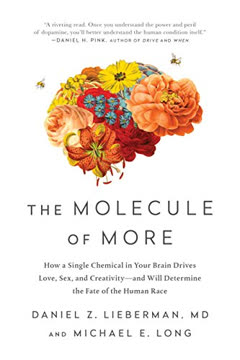Key Takeaways
1. Neuroplasticity: Your Brain's Ability to Change
With neuroplasticity, you set your own potential; without it, you are destined to have a brain set in stone.
Adaptation and Growth. Neuroplasticity is the brain's remarkable ability to reorganize itself by forming new neural connections throughout life. This means that your brain isn't fixed; it's constantly adapting in response to experiences, learning, and even your thoughts. This adaptability is the cornerstone of learning, memory, self-discipline, and habits, allowing you to shape your potential.
Phineas Gage and Phantom Limbs. The case of Phineas Gage, who survived a severe brain injury that dramatically altered his personality, illustrates how physical changes in the brain can affect behavior. Similarly, the phantom limb phenomenon, where amputees feel sensations in missing limbs, demonstrates the brain's capacity to remap itself in response to loss. These examples highlight the brain's incredible malleability.
Not Just for Kids. Neuroplasticity isn't limited to childhood; it continues throughout adulthood. While the brain's development is most rapid in early years, the ability to rewire neural pathways remains, allowing you to learn new skills, break bad habits, and improve cognitive function at any age. This lifelong adaptability empowers you to take control of your brain's development.
2. Structural vs. Functional Neuroplasticity
Structural neuroplasticity concerns the neuronal connections of the brain and the strength of the neural network.
Two Types of Change. Neuroplasticity manifests in two primary forms: structural and functional. Structural neuroplasticity involves physical changes to the brain's structure, such as strengthening or creating new synaptic connections between neurons. Functional neuroplasticity, on the other hand, occurs when the brain adapts by reassigning functions from damaged areas to other, healthier regions.
Building and Strengthening Connections. Structural neuroplasticity is the foundation of learning and habit formation. Repetitive actions and thoughts reinforce specific neural pathways, making those behaviors more automatic over time. This is how skills are acquired and habits are ingrained, shaping your behavior and cognitive abilities.
Cortical Remapping. Functional neuroplasticity is often observed in cases of brain injury or sensory deprivation. For example, in amputees experiencing phantom limb sensations, the brain may reassign the area previously dedicated to the missing limb to neighboring regions, leading to the perception of sensations in the absent limb. While fascinating, functional neuroplasticity is less directly controllable than structural changes.
3. Stimulation: The Key to Neural Growth
Stimulation, action, activity, and motion—all in a repetitive manner—are the backbone of neuroplasticity.
Active Engagement. The brain thrives on activity. Stimulation, in the form of learning, new experiences, and challenging tasks, is essential for promoting neural growth and strengthening connections. Passive activities, like watching television, offer limited stimulation and may not contribute significantly to neuroplasticity.
Lifelong Learning. Continuous learning is crucial for maintaining brain health and promoting neuroplasticity. Engaging in activities that challenge your mind, such as learning a new language, playing a musical instrument, or studying a complex subject, can stimulate the formation of new neural connections and improve cognitive function.
Whole Brain Thinking. Engaging both hemispheres of the brain can maximize stimulation. Activities that combine logical and analytical thinking with creativity and emotional expression can promote more balanced brain development. For example, learning to play chess while also pursuing artistic endeavors can stimulate different areas of the brain.
4. Enrich Your Environment for Passive Brain Growth
Surroundings that provoke thought, seize your attention, and are full of novelty are ideal.
Passive Stimulation. An enriched environment provides constant, passive stimulation that promotes neural growth without requiring conscious effort. By surrounding yourself with stimulating elements, you can create an environment that automatically encourages brain activity.
Elements of an Enriched Environment:
- Social: Quality interactions with others improve empathy and social intelligence.
- Physical: Opportunities for physical activity enhance motor skills and coordination.
- Sensory: Engaging the senses with interesting sights, sounds, smells, and textures can improve awareness and sensory perception.
- Nutritional: Easy access to healthy foods supports brain health and function.
The Rat Study. Dr. Marian Diamond's study with rats demonstrated the impact of environment on brain development. Rats in stimulating cages with toys and activities showed greater brain growth compared to those in barren cages, highlighting the importance of environmental enrichment.
5. Methodical, Persistent, and Repetitive Action
Habits aren’t formed in a day (in fact, studies have shown it takes at least two months to form a habit) and it’s near impossible to memorize all 50 states of the United States in one sitting.
Consistency Over Time. Neuroplasticity requires consistent effort and repetition. Like carving the Grand Canyon, neural pathways are strengthened through gradual, persistent action over time. There are no quick fixes or shortcuts to rewiring the brain.
Principles of Effective Retraining:
- Use it or lose it: Neural pathways that aren't actively used are pruned.
- Repetition matters: Repeated practice strengthens neural connections.
- Intensity matters: Challenging tasks have a greater impact on synaptic connections.
- Salience matters: Activities relevant to your life are more effective.
- Transference and generalization matter: Skills applicable to multiple scenarios are more valuable.
Grand Canyon Analogy. The formation of the Grand Canyon serves as a powerful analogy for neuroplasticity. Just as a small river gradually carved a massive chasm over millions of years, consistent effort and repetition can reshape the brain over time.
6. Prioritize Brain Health: Stress, Sleep, and Exercise
The brain is just like any other part of your body in that it needs to be taken care of physically.
The Foundation of Neuroplasticity. Just like an athlete needs to care for their body, the brain requires proper physical care to function optimally. Stress, sleep deprivation, and lack of exercise can hinder neuroplasticity and limit your ability to effect neural change.
Stress Management. Chronic stress can shrink the brain and impair cognitive function. Managing stress through techniques like meditation, mindfulness, or spending time in nature is crucial for maintaining brain health. Acute stress, while temporary, can also negatively impact cognitive performance.
Sleep and Memory Consolidation. Sleep is essential for memory consolidation and learning. During sleep, the brain processes and stores information, strengthening neural connections. Sleep deprivation can impair cognitive function and hinder neuroplasticity.
Exercise and Brain Growth. Physical exercise promotes the production of brain-derived neurotrophic factor (BDNF), a protein that supports brain health and growth. Exercise can also improve blood flow to the brain, delivering essential oxygen and nutrients.
7. Harness the Neuroscience of "Yes"
If you start feeling good in anticipation of something, chances are you will be motivated into action to seek more of it.
Dopamine and Motivation. The "yes" response, characterized by motivation, discipline, and focus, is closely linked to the neurotransmitter dopamine. Dopamine is released in anticipation of and during pleasurable experiences, driving us to seek out rewards.
The Pleasure Principle. The pleasure principle, which states that humans are motivated to seek pleasure and avoid pain, is a fundamental driver of behavior. By understanding how pleasure and reward influence our actions, we can harness the power of dopamine to enhance motivation.
The Inhibition System. The brain's inhibition system, controlled by the ventrolateral prefrontal cortex (VLPFC), helps us focus and resist distractions. Strengthening the VLPFC can improve self-discipline and enhance our ability to say "yes" to our goals.
8. Rewire the "No" Response with Cognitive Behavioral Therapy
Prolonged stress creates structural changes—the groove is being worn in such a way that you are creating a stressed brain unable to process in any other way.
Fear and Anxiety. The "no" response, driven by fear and anxiety, originates in the limbic system, particularly the amygdala. This system prioritizes survival and security, often leading to irrational fears and avoidance behaviors.
Cognitive Behavioral Therapy (CBT). CBT is a therapeutic approach that aims to change negative thought patterns and behaviors. By identifying and challenging negative core beliefs, CBT can help rewire the brain and reduce the "no" response.
The Thought Diary. A thought diary is a tool used in CBT to track activating events, consequences, and underlying beliefs. By analyzing these patterns, you can identify and challenge negative thought patterns, replacing them with more positive and realistic ones.
9. Habits: The Ultimate Expression of Neuroplasticity
With every repetitive act that we make, our neural pathways get reinforced and restructured until they become automatic channels that dictate what we do.
Automatic Behaviors. Habits are the embodiment of neuroplasticity, representing ingrained patterns of behavior that become automatic over time. Repetitive actions reinforce specific neural pathways, making those behaviors easier to perform and harder to resist.
The Orbitofrontal Cortex and Striatum. The orbitofrontal cortex, responsible for decision-making, and the striatum, which coordinates repetitive behaviors, play key roles in habit formation. As conscious decisions are repeatedly made in the orbitofrontal cortex, they become encoded in the striatum, transforming them into automatic habits.
Hebb's Axiom. Hebb's axiom, "cells that wire together, fire together," explains how habits are formed. When a group of neurons consistently activates together, the connections between them strengthen, making it more likely that they will fire together in the future.
10. The Habit Loop: Cue, Routine, Reward
The brain is always trying to make everything it does more time-efficient and productive.
Understanding the Habit Loop. The habit loop is a neurological circuit that governs all habits, consisting of three stages: cue, routine, and reward. The cue triggers the behavior, the routine is the behavior itself, and the reward reinforces the behavior, making it more likely to be repeated.
Breaking Bad Habits. To break a bad habit, you must identify the cue, routine, and reward, then alter the routine while keeping the reward. This involves finding alternative ways to satisfy the craving triggered by the cue.
Building Good Habits. To build a good habit, you must identify a cue, choose a desired routine, and create a reward that reinforces the behavior. This involves making the habit obvious, attractive, easy, and satisfying.
11. If-Then Planning: A Powerful Habit Formation Tool
Deciding exactly when and where you will act on your goal creates a link in your brain between the situation or cue (the if) and the behavior that should follow (the then).
Bridging Intention and Action. If-then planning is a technique that helps bridge the gap between intention and action by creating a specific plan for when and where you will perform a desired behavior. This involves creating "if-then" statements that link a cue to a routine.
The If-Then Formula. If-then statements take the form: "If X happens, then I will do Y." X represents the cue, and Y represents the routine. By creating these statements in advance, you can program your brain to automatically respond to specific cues with desired behaviors.
Increased Success Rates. Studies have shown that if-then planning can significantly increase the likelihood of achieving goals. By creating a clear plan for when and where you will act, you can overcome procrastination and make habit formation more automatic.
Last updated:
FAQ
1. What is "Build a Better Brain" by Peter Hollins about?
- Everyday neuroscience for self-improvement: The book explores how the science of neuroplasticity can be used to train your brain for greater motivation, discipline, courage, and mental sharpness.
- Practical, actionable advice: Hollins translates complex neuroscience into practical steps for readers to reshape their habits, thinking, and behaviors.
- Focus on change and growth: The central theme is that anyone can intentionally rewire their brain to achieve personal and professional goals, regardless of their starting point.
- Covers key brain concepts: The book explains brain structure, neuroplasticity, habit formation, motivation, fear, and how to leverage these for self-development.
2. Why should I read "Build a Better Brain" by Peter Hollins?
- Science-backed strategies: The book provides evidence-based methods for improving mental performance, not just motivational fluff.
- Applicable to daily life: Readers learn how to apply neuroscience to real-world challenges like breaking bad habits, boosting motivation, and overcoming fear.
- Accessible explanations: Hollins makes complex brain science understandable for non-experts, using stories, analogies, and clear language.
- Empowering message: The book emphasizes that your brain is not fixed—change is possible at any age with the right approach.
3. What are the key takeaways from "Build a Better Brain" by Peter Hollins?
- Neuroplasticity is lifelong: Your brain can change and adapt throughout your life, not just in childhood.
- Intentional action is crucial: Positive brain change requires deliberate effort, challenge, and consistency—passive activities don’t lead to growth.
- Habits shape your brain: Both good and bad habits are formed through repeated neural pathways; understanding and altering these is key to self-improvement.
- Overcoming fear and building motivation: The book details how to rewire your brain’s “yes” (motivation) and “no” (fear/anxiety) responses for better outcomes.
4. How does Peter Hollins define neuroplasticity in "Build a Better Brain"?
- Brain’s ability to change: Neuroplasticity is the brain’s capacity to physically and functionally adapt in response to experiences, thoughts, and behaviors.
- Two types explained: Structural neuroplasticity involves strengthening or creating new neural connections through repetition, while functional neuroplasticity refers to the brain reallocating functions after injury or loss.
- Neutral process: Neuroplasticity itself is neither good nor bad; it simply reflects what you repeatedly do or think.
- Foundation for learning and habits: All learning, memory, and habit formation are rooted in neuroplasticity.
5. What are the main brain structures involved in neuroplasticity according to "Build a Better Brain"?
- Prefrontal cortex: Responsible for conscious thought, decision-making, and self-control; the starting point for intentional change.
- Limbic system: Governs emotions, fear, and survival instincts; often in conflict with the rational prefrontal cortex.
- Hippocampus: Central to memory formation and learning; one of the few areas where new brain cells are generated throughout life.
- Basal ganglia and striatum: Key players in habit formation and automatic behaviors; where repeated actions become ingrained.
6. What are the four principles of neural growth in "Build a Better Brain" by Peter Hollins?
- Stimulation is key: Regularly challenge your brain with new, difficult, or unfamiliar tasks to promote growth.
- Enrich your environment: Surround yourself with stimulating, supportive, and varied environments to passively encourage brain development.
- Be methodical, persistent, and repetitive: Consistency and repetition over time are essential for forming lasting neural connections.
- Take care of the engine: Physical health—adequate sleep, exercise, nutrition, and stress management—is vital for optimal brain function and change.
7. How does "Build a Better Brain" explain the neuroscience of motivation and self-discipline?
- Dopamine’s role: Motivation and willpower are closely tied to dopamine, the neurotransmitter associated with pleasure and reward.
- Pleasure principle: The brain is wired to seek pleasure and avoid pain, often prioritizing immediate gratification over long-term goals.
- Inhibition system: The ventrolateral prefrontal cortex helps inhibit distractions and maintain focus, but is easily overridden by strong dopamine-driven urges.
- Visualization and self-talk: Imagining success and using positive self-talk can physically alter brain pathways, boosting motivation and confidence.
8. What is the neuroscience of fear and anxiety in "Build a Better Brain," and how can it be overcome?
- Limbic system and amygdala: Fear and anxiety are rooted in ancient brain structures designed for survival, often triggering fight-or-flight responses.
- Two fear pathways: The amygdala handles fast, automatic fear responses, while the hippocampus processes slower, more thoughtful reactions.
- Fear is both instinctual and learned: Early experiences and repeated exposure can hardwire fear responses, but these can be changed.
- Cognitive Behavioral Therapy (CBT): The book recommends CBT techniques—identifying, analyzing, and restructuring negative thought patterns—to rewire fear-based neural pathways.
9. How does "Build a Better Brain" by Peter Hollins describe the process of habit formation and breaking?
- Habit loop: Habits consist of a cue, routine, and reward; understanding and manipulating each stage is key to change.
- Hebb’s axiom: “Cells that fire together wire together”—repetition strengthens neural pathways, making behaviors automatic.
- Replace, don’t just remove: It’s more effective to replace bad habits with new, positive routines than to simply try to stop them.
- Consistency and patience: Forming or breaking habits takes time (on average, 66 days) and requires small, incremental steps.
10. What is the "if-then" technique in "Build a Better Brain," and how does it help with habit change?
- Implementation intentions: The if-then technique involves planning specific responses to cues (“If X happens, then I will do Y”) to automate desired behaviors.
- Bridges intention and action: By pre-deciding actions, you reduce reliance on willpower and make habits more likely to stick.
- Works for building and breaking habits: Can be used to establish new routines or prevent lapses in challenging situations.
- Supported by research: Studies show people using if-then plans are two to three times more likely to achieve their goals.
11. What are common pitfalls in habit formation according to "Build a Better Brain" by Peter Hollins?
- Trying to change too much at once: Big leaps often fail; small, manageable steps are more sustainable.
- Focusing on stopping old behaviors: It’s more effective to create new, positive habits than to just eliminate bad ones.
- Relying on information alone: Knowledge doesn’t lead to change—action and repetition are necessary.
- Seeking permanent change immediately: Focus on daily rituals and consistency rather than instant, lifelong transformation.
12. What are the best quotes from "Build a Better Brain" by Peter Hollins and what do they mean?
- “Neuroplasticity is the process of the brain developing, changing, growing, and adapting to whatever it is exposed to, and it can be used to quite literally build a better brain.”
Meaning: You have the power to shape your brain and abilities through intentional exposure and practice. - “If you’re sailing through it, nothing’s really happening. Synaptic connections get created through challenge and exertion.”
Meaning: Real growth only happens when you push yourself beyond your comfort zone. - “Cells that fire together wire together.”
Meaning: Repetition and consistency are the foundation of habit and skill formation. - “The brain doesn’t differentiate between real and imagined events.”
Meaning: Visualization and self-talk can physically change your brain, just like real experiences. - “New goals don’t deliver new results. New lifestyles do.”
Meaning: Sustainable change comes from daily habits and rituals, not just setting ambitious goals.
Review Summary
Build a Better Brain receives mostly positive reviews for its accessible explanation of neuroplasticity and practical advice on habit formation. Readers appreciate the concise, science-based approach and find the techniques helpful for personal growth. Many highlight the book's motivational impact and its usefulness for beginners in brain science. Some criticize the lack of detailed citations and editing issues. Overall, reviewers find it a valuable resource for understanding brain function and implementing positive changes, though a few feel it lacks novelty for those familiar with self-improvement literature.
Similar Books










Download PDF
Download EPUB
.epub digital book format is ideal for reading ebooks on phones, tablets, and e-readers.














